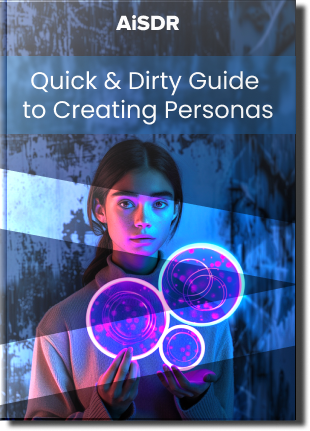Best Examples of Personas for Perfect Customer Modeling

Perfect your customer modeling with these 5 persona examples. Find out how to create detailed personas that empower your marketing strategy.
Do you know who your customers are?
Before you can launch an email campaign, you need to know who you’re talking to.
Personas are a useful way to learn about who your customers are, what motivates them, their pains, and their needs.
With this knowledge in hand, you’ll be able to tailor content so that it resonates with your potential customers.
What is a persona?
A persona is a fictional representation of a group of real people who share certain traits.
For example, a customer persona tries to model your actual and potential customers by highlighting the traits that make people buy your product or service. They’re also the same traits you need to appeal to if you want to make a sale.
Types of personas
There are many types of personas, each of which has a different purpose. In fact, chances are you’ve encountered some of them already.
The most common personas include:
- Customer persona — Represents someone interested in your product and likely to interact with your company during the customer journey. It’s also possible for them to be involved in the buying process.
- Buyer persona — Represents someone interested in buying your product and likely to be heavily involved in the buying process. They might buy it for personal use, for their company, or for another person.
- Marketing persona — Represents someone who receives your marketing communication. They should model your content’s target audience. It’s possible for them to not be buyers or customers.
- User persona — Represents your product’s target user. Target users may or may not be the actual buyers.
- Proto persona — Represents early product-audience hypotheses to provide initial guidance. Generally speaking, this is the persona you have before you collect enough research data.
- Sales persona — Represents someone whose job is to sell your product or service to your ideal customer.
These personas are relatively similar, but each has its nuances.
To illustrate this point, imagine you’re selling a new children’s toy.
The user persona would be the small child who plays with the toy. The buyer persona would be the parent, guardian, or another family member. You might even have a separate marketing persona for the child and the person buying the gift. As for the sales persona, it would be the specialist responsible for the ads that make people want to buy.
What data do personas need?
Let’s assume you’re not selling toys but rather you’re selling product management software for large companies.
Your buyer persona might be product managers or COOs while your marketing persona covers product managers, project managers, and even team leads. If the latter finds your product interesting, they’ll forward it to the buyer for review and consideration.
However, the best personas are built using data, not just hypotheses (excluding the proto-persona, which is supposed to be hypothetical).
When building a persona, you should include this information:
- Demographics (age, gender, location, position, income)
- Behaviors (how they obtain information and make decisions)
- Motivations and goals (what they want to achieve)
- Challenges and pain points (what prevents them from achieving their goal—that’s what your product can help them tackle)

Benefits of personas
A good persona can be the difference between succeeding versus failing in sales. That’s because good personas include enough info and guidance on how to engage and retain customers.
Here are a few of the other benefits of good personas.
Increased sales efficiency
Relevant personas boost your sales efficiency since they help you:
- Prioritize leads – By pursuing leads that match your persona, your sales team is more equipped to close deals since their info at hand is more relevant.
- Customize offers – By addressing your persona’s needs and pain points, you can strike the right chord and appeal to possible buyers.
Improved lead retention and conversion
With existing customers and leads, you can use personas to:
- Make offers more relevant – Knowing your persona’s motivations and goals, you can offer exactly what your leads are looking for with just the right discount or perk, making them more likely to convert.
- Send emails with more meaningful personalization – Messages that contain surface-level, cookie-cutter personalization won’t help you close more revenue. Leveraging personas to deepen personalization will show leads you’ve done your research, which they’ll likely appreciate.
Better targeted marketing
Personas target your marketing efforts more precisely by helping you:
- Choose effective communication channels — If your messaging is sent using your persona’s preferred channel (e.g. email, social media platform, call), people are more willing to engage and you’re likely to see better results.
- Create appealing content — Content created with the right persona in mind will appeal more to real people who share the same interests and pains as the persona.
Examples of personas
Now that we’ve covered which types of personas exist and some of the advantages of using them, here are some examples of personas that you could see in action.
Customer persona
Imagine you sell inventory-management software to large corporations. You know that 60% of your customers work in manufacturing, and 75% of customers are led by male CEOs aged 45-60 years.
Your customer persona might look like this:
| Name | Steven |
| Gender | Male |
| Age | 55 |
| Location | Seattle, WA |
| Job title | Chief Executive Officer |
| Industry | Manufacturing |
| Motivation | Ensure the company operates efficiently Maintain a competitive edge |
| Challenges | Increasingly expensive overhead Poor interdepartmental communication |
To pinpoint your customers’ motivations and challenges, ask them directly whenever possible. When that’s not an option, you can use industry media and market research reports to gain insight into their thinking.
Buyer persona
When creating a buyer persona, you need to know who the decision-maker is that gives the final say for buying products. Let’s say that in 40% of companies, this decision is made by the COO. With that in mind, your buyer persona might look like this:
| Name | Claire |
| Gender | Female |
| Age | 45 |
| Location | Seattle, WA |
| Job title | Chief Operating Officer |
| Industry | Manufacturing |
| Motivation | Streamline operations to improve efficiency |
| Challenges | Increased costs Poor coordination with other departments Risk of disruption when adopting a new system |
If your buyer and customer persona are C-level managers, reaching them directly will be challenging. You’ll likely run into a gatekeeper, which is where a marketing persona can come in handy.
Marketing persona
A marketing persona should generally align with the buyer persona since they’re the ones who will need to bring your product to the buyer’s attention. Such a persona might look like this:
| Name | Emily |
| Gender | Female |
| Age | 32 |
| Location | Seattle, WA |
| Job title | Executive Assistant to the COO |
| Industry | Manufacturing |
| Motivation | Support the COO Provide information for decision-making |
| Challenges | Filtering relevant information from noise Assessing products that are worth considering |
When targeting Emily, you’ll want to phrase your offer in a way that encourages her to forward it to Claire.
User persona
The end user of your product is a staff employee. They’re not the ones who get to decide whether or not to buy your product, but if the decision-makers know employees are unhappy and dislike using your product, the company may stop doing business with you.
A user persona might look like this:
| Name | Michael |
| Gender | Male |
| Age | 40 |
| Location | Seattle, WA |
| Job title | Inventory Specialist |
| Industry | Manufacturing |
| Motivation | Ensure the availability of materials and supplies Reduce waste |
| Challenges | Keeping track of inventory across multiple locations Ensuring accuracy in reporting inventory |
A user persona can greatly benefit your product design and, in turn, sales. When in doubt about whether to add this or that feature, think about whether Michael will need it.
Proto persona
What if you’re a new company and don’t yet have any customers?
That doesn’t mean you should resort to guesswork. Instead, explore market research reports for your industry produced by reputable organizations and look at who’s buying from your closest competitors.
You can use this data to create a proto persona that helps you make initial decisions and get a minimum viable product up and running. Once you have more of your own data, you can use the proto persona as the foundation to build your customer, buyer, marketing, and user personas.
Let’s say you’re offering a workflow automation tool for startups. Your research of competitors shows that CEOs often purchase automation tools directly.
As a result, this might be your possible proto persona:
| Name | Alex |
| Gender | Male |
| Age | 35 |
| Location | San Francisco, CA |
| Job title | Founder & CEO |
| Industry | Tech startup (SaaS) |
| Motivation | Create a breakthrough product despite limited resources |
| Challenges | Managing rapid growth Wearing multiple hats Maximizing limited resources Attracting investment |
Keep in mind that your proto persona might not be 100% accurate. After all, it’s main purpose is to give you something to start with. Just remember that you’ll need to update it once you have more information.











